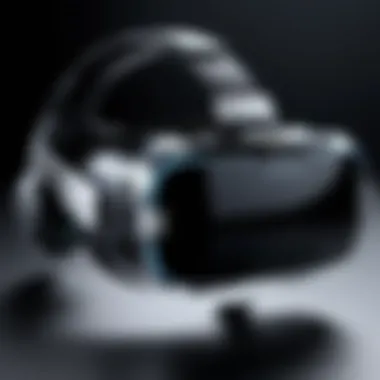Finding the Ideal Price for Virtual Reality Devices


Intro
Navigating the world of virtual reality can feel like exploring a new dimension. As technology rapidly evolves, understanding the price spectrum of these immersive devices becomes crucial for both tech enthusiasts and casual users alike. This isn’t just about spotting the flashiest gadget; it’s about honing in on the best value for what you need. From gamers wanting high-fidelity graphics to professionals in design and simulation, knowing how to evaluate the price based on multiple facets is key.
Market trends shift like quicksand, and with new VR headsets emerging almost daily, consumers often find themselves in a maze of options. In this guide, we will peel back the layers of pricing determination, looking at everything from brand reputations to metrics that matter in performance.
Product Overview
Diving straight into the heart of the matter, let’s break down what you need to know about the main players and specifications that define the VR landscape.
Brand Information
Virtual reality isn’t a one-size-fits-all field. Various brands, such as Oculus, HTC, and Sony, have carved niches for themselves. Each offers unique selling points:
- Oculus: Known for its affordability and user-friendly interface. The Quest series has been particularly popular.
- HTC: Positioned at the higher end, known for superior display and motion tracking capabilities. Their Vive Pro series targets enthusiasts and professionals.
- Sony: Their PlayStation VR is integrated seamlessly into the PlayStation ecosystem, appealing to console gamers.
Key Specifications
When examining the devices, here are some critical specifications:
- Resolution: Ranges usually from 1080p to 4K, affecting visual sharpness.
- Refresh Rate: 72Hz to over 120Hz, impacting smoothness of motion.
- Field of View: Wider views enhance immersion.
- Tracking Method: Inside-out vs outside-in tracking can change user experience significantly.
Pricing
Prices can fluctuate based on features and technology:
- Entry-level devices can cost around $300.
- Mid-range options hover around $600 to $800.
- High-end setups like the HTC Vive Pro can easily exceed $1000, especially when factoring in accessories.
Understanding these elements is vital to make an informed buying decision.
Performance Comparison
When you pull the trigger on a VR purchase, performance is second to none. Not all VR devices are created equal.
Benchmark Tests
Notably, comparing devices involves running benchmark tests which evaluate graphical fidelity and frame rates. For instance, the Oculus Quest 2 often scores high in ease of use versus the more complex setups like the Vive Pro, which, while powerful, require more initial setup.
Speed and Efficiency Comparisons
In terms of processing, devices powered by external PCs, such as the Valve Index, tend to perform better due to their enhanced hardware capabilities. Offloading processing to a console or standalone device can lead to laggy experiences, notably in fast-paced gaming situations.
Features and Technology
Venture deeper into the realm of VR, and you'll discover features that tip the scales in your purchase decisions.
Unique Features
- Hand Tracking: Available on several models, it adds a layer of immersion, enabling users to interact naturally.
- Room Scale Tracking: Allows movement within a designated physical space, creating a holistic experience.
Technological Advancements
The evolution of VR isn’t just linear; think leapfrogging. Newer devices utilize an expanded field of view and improved panel types, making older devices feel insufficient by comparison.
Compatibility with Other Devices
Interoperability matters, especially for gamers. Can the device work with platforms like Steam, Oculus, or PlayStation? Cross-compatibility can enhance its practical use in various scenarios.
Pros and Cons
Every device has its merits and drawbacks; acknowledging these is part of the buying game.
Strengths of the Product
- Exceptional graphics in high-end devices
- Greater immersion with robust tracking and sound capabilities
Areas for Improvement
- Bulkiness: Some headsets aren't as comfortable for long wear.
- Limited library for less popular systems, making access to games a concern.
Value for Money
Ultimately, price tags need to reflect true value.
Cost-effectiveness
While spending a premium can yield cutting-edge specs, less costly options, such as the Oculus Quest 2, provide a commendable VR experience without the wallet pain.
Long-term Benefits
Investing in a quality device today can save money down the line through better game longevity and future-proofing features.
Comparison with Similar Products


Finally, always shine a light on alternatives. Look at brand reviews, but also dissect peer feedback on forums like Reddit or social platforms for grounded insights.
Embarking on a journey through the world of VR pricing need not be daunting. With this guide in hand, may you discern the best device fit for your preferences and needs.
Prolusion to Virtual Reality Pricing
Understanding the pricing of virtual reality (VR) devices is like deciphering a complex code that’s constantly shifting and evolving. In the tech landscape, knowing how much you should pay for a VR device isn't just about looking at the price tag; it’s about weighing various elements like performance, brand reputation, and technological advancements. Given the rapid pace at which VR technology is progressing, consumers must navigate this arena armed with pertinent knowledge to make a sound investment.
Having a grasp of what contributes to the pricing of these devices can uncover potential benefits and drawbacks. With VR gaming and professional applications gaining steddily popularity, the landscape offers a plethora of choices at varying price points, making it essential to assess what each device brings to the table in terms of quality, functionality, and overall value.
It’s important to remember that not all VR devices are created equal. There are budget-friendly options intended for the casual user, while premium models cater to serious gamers and professionals. Evaluating these differences is critical and helps inform which price aligns best with your personal or professional needs.
"Knowledge is power, and in the realm of virtual reality pricing, it’s a guiding light through a maze of choices."
By dissecting the intricate layers of VR pricing, this article aims to equip readers with insights that go beyond superficial comprehension. You’ll learn about the factors that influence prices, the evolution of the market, and how various models stack up against one another. Each detail matters in the quest for the best price, ensuring you don’t overspend while still attaining the immersive experiences that VR has to offer.
Understanding Virtual Reality
To fully appreciate the nuances of pricing, it’s crucial to establish what virtual reality actually entails. At its core, VR is a technology that simulates an immersive environment through computer-generated content, enabling users to interact with that space through specialized equipment. Devices like the Oculus Quest, Valve Index, and HTC Vive are some of the leading examples of how VR creates a rich and engaging experience.
Furthermore, VR isn't just limited to gaming. It’s also being used in training, education, and even therapy. This broader application has amplified the demand—and subsequently the pricing—for VR devices. Understanding various VR applications and how they play into price considerations can provide potential buyers with a clearer focus when shopping around.
The Evolution of VR Pricing
History often provides the best clues into the present, and the pricing structure of VR devices is a classic case. The VR market has come a long way from its beginnings in the late 20th century. Initially reserved for research labs and high-end simulations, VR technologies gradually transitioned into mainstream consumer markets during the 2010s.
The initial launch of devices like the Oculus Rift introduced a wave of excitement but often came with a hefty price tag. As competition increased and technology advanced, prices began to shift dramatically.
By analyzing trends, one can discern that:
- Early VR devices had high retail prices, reflecting their novelty and limited technical capabilities.
- As more players entered the field, prices began to stabilize, offering a mix of budget and premium options.
- The rapid evolution in technology—like improved graphics and more advanced tracking systems—has caused some earlier models to depreciate faster than anticipated, making way for newer generations.
In essence, the evolution of VR pricing isn't just a simple narrative about ups and downs; it encapsulates how consumer demand, technological advancements, and market competition intertwine. Understanding this evolution aids buyers in grasping the larger picture of VR pricing, paving the way for educated purchasing decisions.
Key Factors Impacting VR Prices
When embarking on the quest to determine a suitable price for virtual reality devices, understanding the key factors impacting VR prices is of primary importance. This section sheds light on the critical elements that dictate pricing in the VR market, helping consumers make informed decisions while navigating the wealth of choices available. Recognizing how technology specifications, brand reputation, and market demand contribute to price points can empower tech enthusiasts, gamers, and IT professionals alike.
Technology Specifications
Display Quality
Display quality serves as a cornerstone of the virtual reality experience. High-resolution screens create a more immersive environment, allowing users to explore virtual worlds without the distraction of pixelation. A notable characteristic of display quality is refresh rate, which determines how smoothly the visuals appear. Devices boasting higher display resolutions, such as 4K or even 8K, are gaining traction as they cater to the demands of users seeking crystal-clear clarity.
One unique feature of high-quality displays is the use of OLED technology, which delivers vibrant colors and deeper blacks. This advantage significantly enhances the user experience, making it a compelling choice for avid gamers and VR content creators. However, these standout features often come at a premium price, prompting buyers to weigh their options against their budget constraints.
Field of View
Field of view is another essential parameter that contributes heavily to the overall immersion level in virtual reality. A broad field of view allows users to see more of the virtual environment, creating a sense of presence and realism. Devices with a wider field of view, typically exceeding 110 degrees, are considered more advantageous due to the enhanced spatial awareness they provide.
The distinct feature here is the peripheral vision, which is crucial in many VR applications, especially when gaming or participating in simulations. The downside, however, can be the increased cost associated with the technology that supports larger fields of view, which certainly needs to be factored into any buying decision.
Refresh Rate
Refresh rate significantly impacts how fluidly movement translates in the virtual space. Devices that operate at higher refresh rates, such as 90 Hz or more, provide a more responsive experience. The key aspect of refresh rate facilitates a smoother visual flow, reducing motion blur and the risk of motion sickness—an often overlooked problem in virtual reality.
The feature of dynamic refresh rate adjustment is starting to find its way into newer models. This allows the VR device to automatically adapt its refresh rate to the performance requirements of the application being used. The trade-off? While this innovation may enhance the user experience, it also tends to drive up the price, making it imperative to find a balance between desired performance and budget.
Brand Influence
Brand influence plays a pivotal role in VR pricing dynamics. High-profile companies often command customer loyalty, which can justify increased prices. The established reputation for quality and performance can make certain brands more appealing, influencing buyers’ perceptions about value.
A prime example can be seen in how options from leading manufacturers like Oculus or HTC Vive might come with higher price tags owing to brand value. This often translates into a sense of reliability, inspiring trust in both performance and customer support. However, the downside is that consumers might overlook other devices that offer excellent functionality at lower costs, simply due to brand familiarity.
Market Demand
Trends in Gaming
The intersection of virtual reality and gaming has seen explosive growth. As more titles are developed for VR platforms, gaming demand directly influences pricing. The popularity of certain genres, such as immersive simulations or action-packed adventures, drives up interest in VR devices capable of delivering unparalleled experiences.
What stands out is the seasonality of game launches. During peak gaming seasons, prices can fluctuate, with brands keen on capitalizing on demand spikes. While gamers can snag discounts during off-peak seasons, waiting for the next big game release may bring about price hikes on popular devices, causing consumers to play pricing strategy as much as they play the games themselves.
Professional Applications
The commercial use of virtual reality, ranging from training simulations to virtual conferences, has been steadily gaining traction. Professional applications often involve higher budget allocations, thus raising the overall perceived value of VR devices. This demand has catalyzed innovations specifically tailored for industries such as healthcare, education, and real estate.
Interestingly, the unique feature of custom software development tailored for specific business needs often justifies premium pricing. The flip side is that small businesses may find themselves facing hurdles in affording high-end devices, which emphasizes the importance of scalability in VR technology to meet various market levels without compromising quality.
Comparative Analysis of Leading VR Models
In the world of virtual reality, being able to differentiate between the various models available is essential for making a well-informed purchasing decision. With a plethora of choices, ranging from affordable entry-level devices to high-end premium gadgets, a comparative analysis becomes a necessity. It not only illuminates the unique strengths and weaknesses of each model, but also helps consumers align their preferences and needs with the right device. The importance of this analysis cannot be overstated, especially when considering the rapid advancements in technology. Below, we take a closer look at the leading VR models currently on the market, exploring how each stacks up against the other.
Oculus Quest Series
The Oculus Quest series stands as a landmark in the virtual reality domain, primarily due to its untethered design and user-friendly interface. These standalone headsets mark a departure from the need to connect to hefty PCs or consoles. They come loaded with an array of games and applications, making them accessible for newcomers and seasoned gamers alike.


- Key Features:
- All-in-One Experience: No wires mean greater freedom, enhancing user immersion.
- User Friendly: Set up is straightforward; even those who aren't tech-savvy can get going in no time.
- Growing Library: The Quest Store continues to expand, fostering a community that thrives on sharing experiences.
However, some may argue that it sacrifices graphical prowess compared to tethered alternatives. The compromise here appears to be that while you're gaining portability, there’s a cutback on the raw power expected from high-end VR systems.
Valve Index
Valve's Index is a name that resonates deeply within the hardcore gaming and VR circles. Unlike the Oculus Quest, the Index requires a connection to a powerful gaming PC, which many consider both a burden and a boon. The need for high-end hardware means that this model is often seen as an investment.
- Unique Selling Points:
- Superior Visuals: The display quality is quite exceptional, boasting a resolution that delights the eyes.
- High Refresh Rate: With capabilities up to 144Hz, it reduces latency and enhances responsiveness, appealing to competitive players.
- Excellent Controllers: The finger-tracking controllers add a level of immersion that is unmatched in the VR landscape.
For serious gamers willing to spend a bit more, the Valve Index offers unparalleled experiences. However, it does come with its quirks, such as a steep learning curve that can be daunting for newcomers.
HTC Vive Lineup
The HTC Vive lineup represents a deep legacy in VR innovation, staying a step ahead by integrating advanced technology into their devices. The Vive series has a reputation for excellence, yet the varied models can sometimes confuse potential buyers.
- Highlights:
- Room-Scale Tracking: This feature provides more physical interaction space, making users feel more engaged in their surroundings.
- Versatile Options: From the entry-level Vive Focus to the robust Vive Pro, there's something for everyone.
- Compatibility: Their devices often support third-party accessories to enhance the experience further.
Nevertheless, the price point is often seen as high for many models, causing potential buyers to weigh the benefits against their wallet's depth.
PlayStation VR
Sony's PlayStation VR has captured the attention of console gamers, integrating the accessibility of VR into the PlayStation ecosystem. Being console-compatible makes the PS VR a popular choice for many who are already invested in Sony's gaming environment.
- Advantages:
- Affordable Entry Point: Compared to PC-based systems, the PS VR often comes cheaper, making it less painful on the pocket.
- Extensive Game Library: With exclusive titles only available on PlayStation, it draws in many users eager to experience them.
- Solid Performance: Although it may not match the premium options in terms of specs, it delivers a solid experience that satisfies most casual players.
On the flip side, its reliance on the PlayStation console can limit those looking for a standalone experience. Still, its ease of access has made it one of the more sought-after models.
In sum, a comparative analysis of these models showcases how various aspects cater to different audiences. Whether it be performance, cost, or unique features, understanding these distinctions is essential for making an informed decision as you step into the world of virtual reality.
Budget versus Premium VR Options
When it comes to selecting a virtual reality device, one of the most significant considerations rests on the spectrum of budget versus premium options. As VR technology continues to advance, defining the boundaries between what is considered affordable and what is deemed top-tier can get murky. Understanding this distinction can greatly influence a consumer's decision, shedding light on the essential elements, benefits, and drawbacks associated with both categories.
Identifying Budget Devices
During the exploration of affordable VR devices, it's crucial to pinpoint what makes them appealing and viable for those not looking to break the bank. Affordable options often cater primarily to casual users, hobbyists, or those who want a taste of VR without emptying their wallets.
Features of Entry-Level VR
Entry-level VR devices typically showcase a range of noticeable features while still prioritizing affordability. A key characteristic of these devices is their plug-and-play accessibility, meaning they usually don’t require high-end gaming rigs or extensive setup procedures. This ease of use makes them a favorite among new users.
One unique aspect of entry-level VR is their mobile compatibility. Devices like the Oculus Quest 2 allow usage without the need for a computer or console, making them particularly* beneficial for on-the-go gaming or casual experiences. However, they often come with limitations in performance, like a reduced field of view and lower resolution compared to their premium counterparts, possibly leading to a less immersive experience than players may desire.
Common Trade-offs
When discussing budget devices, common trade-offs are often unavoidable. Users typically face a pick-your-poison scenario, weighing which features to sacrifice for cost savings. A prominent characteristic is the limited graphics capabilities and less sophisticated tracking technology found in these devices. While they are affordable and offer a gateway into VR, this often results in less accurate motion tracking or lower visual fidelity.
One distinctive feature in this category is a lack of extensive game libraries. While entry-level VR devices can access many popular titles, the full spectrum of immersive experience found on premium devices may be out of reach. This trade-off means that consumers might miss out on specific advanced functionalities that enhance gameplay, ultimately leading to frustration if expectations were set too high.
Benefits of Premium Models
On the flip side, premium VR devices present a compelling argument for those willing to invest more upfront, particularly gamers and professionals seeking the fullest possible experience that VR can offer.
Advanced Functionality
Premium devices often leverage cutting-edge technology. This results in significantly better performance metrics, including sharper visuals, improved refresh rates, and more seamless motion tracking. A defining characteristic of premium models is the highly immersive environments they create, which makes them a go-to choice for avid gamers and professionals who rely on VR for simulations and training.
A standout feature includes advanced haptic feedback technologies that provide users with a more tactile sense of engagement with their virtual surroundings. This adds another layer of realism, making experiences more vibrant and engaging. However, the cost associated with these devices can often run high, which may deter budget-sensitive users from investing.
Future-Proofing
Another crucial advantage of premium VR options is future-proofing. Being equipped for upcoming software updates and a broader array of supported games ensures that your investment doesn’t become obsolete shortly after purchase. Premium devices often provide superior upgradability, meaning they're more capable of adapting to new developments in VR technology.
Unique aspects of future-proofing include compatibility with upcoming platforms and continuous improvements in graphical capabilities, making these devices more resilient against market changes. While this represents a higher initial outlay, the long-term benefits can substantially outweigh the costs for consumers willing to make that commitment.
Evaluating Price-to-Performance Ratio
In the quest for the best virtual reality device, one cannot overlook the price-to-performance ratio. This critical metric serves as a guiding star for tech enthusiasts as it reflects how much value one receives per dollar spent. Essentially, it helps consumers grasp whether a device's features and capabilities justify its price tag. In the VR landscape, where costs can soar, understanding this ratio becomes paramount for making smart decisions. Evaluating price-to-performance isn’t merely about finding a bargain, but also about investing wisely in technology that meets your specific needs.
Key Metrics for Evaluation
Cost per Performance Unit
The Cost per Performance Unit is an essential feature when analyzing a device’s value. This metric breaks down the total cost of a VR device against its performance capabilities, providing insights on whether you’re getting your money’s worth. For instance, a headset that retails at a higher price might have superior specifications like tracking accuracy or resolution. Yet, if that device underperforms in terms of the variety of compatible games and applications, its cost per performance unit could be less favorable.
Interestingly, this ratio can vary widely between models. A device hailing from a lesser-known brand might offer a significantly better cost per performance ratio than a premium brand. Consumers who keep their eyes peeled for these nuances can certainly snag a fantastic deal. Still, when calculating costs, one must also consider long-term expenses, such as subscription services or accessories that could raise the overall price. This assessment makes cost per performance a popular criterion because it considers both current and future expenditures when determining the true value of a VR headset.


User Experience Feedback
Understanding User Experience Feedback is another pivotal aspect of evaluation. This metric encompasses reviews and ratings from actual users who have hands-on experience with the product. Often, specs on paper might promise a lot, but real-life usage can tell a whole different story. User feedback sheds light on aspects like comfort during extended use, ease of setup, and the overall enjoyment of the VR experience.
When users detail their experiences, they highlight what makes certain devices shine — be it immersive graphics, audio quality, or even the intuitiveness of controls. Feedback often reveals muddled expectations versus reality, leading to a more informed purchasing choice. By relying on user experiences, potential buyers can understand not just how a device performs against its specs but how it holds up in day-to-day scenarios.
Incorporating user feedback puts more weight behind the cost per performance analysis. A headset that appears expensive upfront might be justified if users rave about its comfort and intuitive design. Thus, this metric becomes an influential and beneficial piece of the price-to-performance puzzle.
Industry Benchmarks
When looking at Industry Benchmarks, one must note the standards set by the leading VR devices in the market. These benchmarks serve as reference points, providing clarity on what consumers should expect from different price ranges. They encompass various components, including graphical fidelity, motion tracking accuracy, and system compatibility.
Adhering to these industry standards allows buyers to gauge whether a device is priced fairly according to its performance level. Devices that stretch beyond these benchmarks often justify their higher price through advanced functionalities. Conversely, if a device falls short against industry benchmarks, it raises a red flag regarding its value. Ultimately, relying on industry benchmarks can help level the playing field across diverse VR products, ensuring consumers have a clear frame of reference as they navigate this often-confusing market.
Long-Term Value Considerations
When investing in a virtual reality device, it’s crucial to consider the long-term value that comes with that purchase. The world of VR is in a constant state of flux, with frequent updates and new models hitting the market. Because of this, understanding what contributes to the device's long-term value can significantly impact your overall satisfaction and usability over time.
Two main elements will be discussed:
- Durability and Depreciation
- Ecosystem Compatibility
Each of these factors plays a pivotal role in ensuring that your investment is more than just a fleeting novelty. Let’s break them down.
Durability and Depreciation
Durability is more than a buzzword; it represents the longevity of your device amidst rigorous daily use. When choosing a VR headset, look closely at the materials used in production, the construction quality, and real-life user feedback regarding wear and tear. Devices that use robust materials will often withstand the test of time.
It's worth noting that depreciation is another crucial aspect. Every piece of tech loses value over time, and VR devices are no exception. But some models retain their resale value better than others. Brands known for reliability often experience less rapid depreciation. This allows owners to recoup a significant portion of their investment if they choose to upgrade or switch brands.
In short, assess how well your prospective device stands up against potential misuse and whether it has a history of holding its worth in the marketplace.
Ecosystem Compatibility
Ecosystem compatibility evaluates how well a VR device integrates into the broader tech landscape, and this can greatly affect its long-term usability. Devices don’t exist in isolation; they are expected to work seamlessly with a myriad of games, software, and other devices.
Game and Software Availability
The availability of games and software is a key characteristic for any VR platform. When a wide array of options is available, it enriches the user experience, enabling access to diverse content across various genres. Imagine sinking into a game that transports you to new worlds or simulations that help you enhance skills—these involve software that fits your interests.
A particular strength of platforms with extensive libraries like Valve's Steam or PlayStation VR is that they frequently receive support and updates, keeping content fresh and appealing. However, if a VR device limits you to a small niche of games, it can lead to buyer’s remorse as interest wanes.
Aspects of Cross-Platform Support
Cross-platform support has emerged as a significant factor in the VR market. This feature allows users the flexibility to enjoy their VR experiences across various devices and platforms, enhancing its appeal. Devices that support multiple platforms can be considered a wise investment, as they open up a plethora of possibilities for content exploration.
Furthermore, when a device allows users to seamlessly transition between different hardware, it reduces the potential feeling of being ‘locked in’ with a single brand. On the flip side, some devices only operate within their ecosystem, which might limit access to a wider array of content and experiences.
Consumer Reviews and Expert Opinions
Understanding the consumer reviews and expert opinions surrounding virtual reality devices can be a game changer for anyone serious about purchasing a headset. This section is vital, as user feedback sheds light on practical aspects of the devices that might not be covered in technical specifications. While manufacturers often tout the numbers, real users provide insight into the actual performance—things like comfort during long use, reliability, and overall enjoyment.
Compilation of User Experiences
User experiences provide a treasure trove of valuable data. When diving into reviews posted on platforms such as Reddit or specialized VR forums, one can see patterns emerge. Common themes often surface, which include:
- Comfort: Many users comment on how a device feels during extended sessions. A headset that's snug without being too tight can significantly enhance the experience.
- Setup and Ease of Use: Some headsets shine in terms of how simple they are to set up. Users appreciate intuitive software and easily adjustable hardware.
- Game Library: A rich offering can elevate a device's appeal. Reviews frequently mention how many standout titles there are available for their headset.
- Longevity of Use: There are accounts of devices that stand the test of time while others quickly become outdated as new models are released.
Collectively, these reviews can underscore serious considerations when selecting the best VR device. They highlight what features truly resonate with users and where certain products may fall short in real-world applications.
Expert Review Analysis
On the flip side, expert reviews bring heft to the conversation. Tech professionals often conduct thorough evaluations, ensuring that their assessments are grounded in technical know-how. These reviews often delve into areas such as:
- Technical Competence: Experts assess components such as display technology, processing power, and tracking accuracy.
- Comparative Insights: They draw comparisons between models based on performance, helping you understand which device excels in which area. for instance, "While the Valve Index boasts superior tracking, the Oculus Quest's standalone functionality cannot be denied."
- Future Prospects: Industry experts often provide foresights into the future, considering how updates or new technology might impact devices down the line.
"User reviews capture the heartbeat of the market while expert opinions provide the technical backbone that supports purchasing decisions."
Navigating through both consumer reviews and expert analyses allows for a well-rounded understanding of any potential investment in virtual reality technology. It helps consumers bridge that gap between cold, hard stats and personal experience, ultimately facilitating a more informed buying decision.
Ending: Making Informed Choices
In the world of virtual reality, making informed choices is imperative to ensure that both your investment and user experience align with your expectations. Embracing technology without thorough research can lead to buyer's remorse, especially with the price ranges varying greatly across devices and brands. Ultimately, consumers need to navigate the landscape equipped with a solid understanding of what defines value in the realm of VR device pricing.
When considering the purchase of a virtual reality headset, keeping an eye on several essential elements is crucial. These include the specifications that truly influence performance, the reputation of brands, and understanding market dynamics that dictate demand and prices. Price does not only reflect the device's build but also its longevity, performance capabilities, and compatibility with potential software ecosystems you plan to engage with.
Summarizing Key Insights
To distill the significant points discussed throughout the article:
- Market Influence: Prices for VR devices are highly susceptible to market trends. New releases often bring older models down in price, affecting their perceived value.
- Technological Advancements: Features such as display quality, refresh rate, and field of view directly affect how immersive and enjoyable the experience will be, and hence should be top of mind when assessing price.
- Competitive Landscape: With brands like Oculus, HTC, Valve, and PlayStation all vying for consumer attention, it's critical to assess which devices in each line offer the best balance of price and performance.
- Future-Proofing Aspects: Opting for devices that offer extensibility or compatibility with a wider range of software/resources can help ensure that you're investing for the long haul rather than just for now.
"Knowledge is power, and in terms of VR devices, it can help safeguard your wallet."
Final Recommendations
Here are some straightforward recommendations to consider:
- Set a Budget: Before you even start browsing, determine how much you are willing to spend. It’ll help narrow down your options significantly.
- Research Specification: Look for headsets that match your intended use—gaming, professional applications, or general exploration. Focus on features that matter for your needs.
- Read Reviews: Dive into consumer experiences and expert reviews before making a decision. It’s astounding how much light user experiences can shed on a device’s real-world performance.
- Watch for Deals: Keep your eyes peeled for seasonal discounts or bundle offers that can provide additional value or savings, especially for entry-level users.
- Consider Ecosystem: Ensure that the device you choose will be compatible with what you plan to use it for. Device ecosystems can have a huge impact on future purchasing decisions for games and experiences.
The culmination of these insights and recommendations arms consumers with a robust framework for navigating the exciting yet intricate world of virtual reality pricing.







